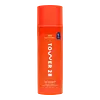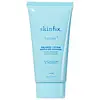What's inside
What's inside
 Key Ingredients
Key Ingredients

 Benefits
Benefits

 Concerns
Concerns

 Ingredients Side-by-side
Ingredients Side-by-side

Water
Skin ConditioningDecyl Glucoside
CleansingAloe Barbadensis Leaf Juice
Skin ConditioningNiacinamide
SmoothingCaprylyl/Capryl Glucoside
CleansingPhenoxyethanol
PreservativeGlycerin
HumectantCaprylyl Glycol
EmollientCitric Acid
BufferingChlorphenesin
AntimicrobialMagnesium Aspartate
Skin ConditioningZinc Gluconate
Skin ConditioningAlgin
MaskingAchillea Millefolium Extract
CleansingAvena Sativa Kernel Extract
AbrasiveCardiospermum Halicacabum Flower/Leaf/Vine Extract
Skin ConditioningSapindus Mukorossi Peel Extract
Skin ConditioningPanthenol
Skin ConditioningCopper Gluconate
Skin ConditioningWater, Decyl Glucoside, Aloe Barbadensis Leaf Juice, Niacinamide, Caprylyl/Capryl Glucoside, Phenoxyethanol, Glycerin, Caprylyl Glycol, Citric Acid, Chlorphenesin, Magnesium Aspartate, Zinc Gluconate, Algin, Achillea Millefolium Extract, Avena Sativa Kernel Extract, Cardiospermum Halicacabum Flower/Leaf/Vine Extract, Sapindus Mukorossi Peel Extract, Panthenol, Copper Gluconate
Water
Skin ConditioningGlycerin
HumectantSodium Cocoyl Isethionate
CleansingCocamidopropyl Hydroxysultaine
CleansingSodium Lauroyl Methyl Isethionate
CleansingSodium Methyl Cocoyl Taurate
CleansingCocamidopropyl Betaine
CleansingSodium Methyl Oleoyl Taurate
CleansingLauryl Glucoside
CleansingCoco-Glucoside
CleansingCoconut Acid
CleansingJojoba Oil/Macadamia Seed Oil Esters
Skin ConditioningSodium Chloride
MaskingSodium Isethionate
CleansingEctoin
Skin ConditioningSqualene
EmollientOligopeptide-1
Skin ConditioningOligopeptide-2
Skin ConditioningOligopeptide-3
Skin ConditioningHexapeptide-11
Skin ConditioningCeramide EOP
Skin ConditioningPropanediol
SolventHydroxyectoin
BufferingNiacinamide
SmoothingAmylopectin
Bacillus
Skin ConditioningFolic Acid
Skin ConditioningSodium Hyaluronate
HumectantPentylene Glycol
Skin ConditioningInulin
Skin ConditioningPhytosteryl Macadamiate
Skin ConditioningLecithin
EmollientAcetyl Glutamine
Skin ConditioningChamomilla Recutita Flower Extract
MaskingLithothamnion Calcareum Extract
Skin ConditioningLactic Acid
BufferingPhytosterols
Skin ConditioningAlpha-Glucan Oligosaccharide
CleansingSodium Lauroyl Lactylate
EmulsifyingTocopherol
AntioxidantSodium Benzoate
MaskingCaprylyl Glycol
EmollientPolyglutamic Acid
Skin ConditioningCeramide NP
Skin ConditioningCeramide AP
Skin ConditioningPhytosphingosine
Skin ConditioningCholesterol
EmollientCarbomer
Emulsion StabilisingCitric Acid
BufferingXanthan Gum
EmulsifyingPotassium Sorbate
PreservativeEthylhexylglycerin
Skin ConditioningPhenoxyethanol
PreservativeWater, Glycerin, Sodium Cocoyl Isethionate, Cocamidopropyl Hydroxysultaine, Sodium Lauroyl Methyl Isethionate, Sodium Methyl Cocoyl Taurate, Cocamidopropyl Betaine, Sodium Methyl Oleoyl Taurate, Lauryl Glucoside, Coco-Glucoside, Coconut Acid, Jojoba Oil/Macadamia Seed Oil Esters, Sodium Chloride, Sodium Isethionate, Ectoin, Squalene, Oligopeptide-1, Oligopeptide-2, Oligopeptide-3, Hexapeptide-11, Ceramide EOP, Propanediol, Hydroxyectoin, Niacinamide, Amylopectin, Bacillus, Folic Acid, Sodium Hyaluronate, Pentylene Glycol, Inulin, Phytosteryl Macadamiate, Lecithin, Acetyl Glutamine, Chamomilla Recutita Flower Extract, Lithothamnion Calcareum Extract, Lactic Acid, Phytosterols, Alpha-Glucan Oligosaccharide, Sodium Lauroyl Lactylate, Tocopherol, Sodium Benzoate, Caprylyl Glycol, Polyglutamic Acid, Ceramide NP, Ceramide AP, Phytosphingosine, Cholesterol, Carbomer, Citric Acid, Xanthan Gum, Potassium Sorbate, Ethylhexylglycerin, Phenoxyethanol
 Reviews
Reviews

Ingredients Explained
These ingredients are found in both products.
Ingredients higher up in an ingredient list are typically present in a larger amount.
Caprylyl Glycol is a humectant and emollient, meaning it attracts and preserves moisture.
It is a common ingredient in many products, especially those designed to hydrate skin. The primary benefits are retaining moisture, skin softening, and promoting a healthy skin barrier.
Though Caprylyl Glycol is an alcohol derived from fatty acids, it is not the kind that can dry out skin.
This ingredient is also used as a preservative to extend the life of products. It has slight antimicrobial properties.
Learn more about Caprylyl GlycolCitric Acid is an alpha hydroxy acid (AHA) naturally found in citrus fruits like oranges, lemons, and limes.
Like other AHAs, citric acid can exfoliate skin by breaking down the bonds that hold dead skin cells together. This helps reveal smoother and brighter skin underneath.
However, this exfoliating effect only happens at high concentrations (20%) which can be hard to find in cosmetic products.
Due to this, citric acid is usually included in small amounts as a pH adjuster. This helps keep products slightly more acidic and compatible with skin's natural pH.
In skincare formulas, citric acid can:
While it can provide some skin benefits, research shows lactic acid and glycolic acid are generally more effective and less irritating exfoliants.
Most citric acid used in skincare today is made by fermenting sugars (usually from molasses). This synthetic version is identical to the natural citrus form but easier to stabilize and use in formulations.
Read more about some other popular AHA's here:
Learn more about Citric AcidGlycerin is already naturally found in your skin. It helps moisturize and protect your skin.
A study from 2016 found glycerin to be more effective as a humectant than AHAs and hyaluronic acid.
As a humectant, it helps the skin stay hydrated by pulling moisture to your skin. The low molecular weight of glycerin allows it to pull moisture into the deeper layers of your skin.
Hydrated skin improves your skin barrier; Your skin barrier helps protect against irritants and bacteria.
Glycerin has also been found to have antimicrobial and antiviral properties. Due to these properties, glycerin is often used in wound and burn treatments.
In cosmetics, glycerin is usually derived from plants such as soybean or palm. However, it can also be sourced from animals, such as tallow or animal fat.
This ingredient is organic, colorless, odorless, and non-toxic.
Glycerin is the name for this ingredient in American English. British English uses Glycerol/Glycerine.
Learn more about GlycerinNiacinamide is a multitasking form of vitamin B3 that strengthens the skin barrier, reduces pores and dark spots, regulates oil, and improves signs of aging.
And the best part? It's gentle and well-tolerated by most skin types, including sensitive and reactive skin.
You might have heard of "niacin flush", or the reddening of skin that causes itchiness. Niacinamide has not been found to cause this.
In very rare cases, some individuals may not be able to tolerate niacinamide at all or experience an allergic reaction to it.
If you are experiencing flaking, irritation, and dryness with this ingredient, be sure to double check all your products as this ingredient can be found in all categories of skincare.
When incorporating niacinamide into your routine, look out for concentration amounts. Typically, 5% niacinamide provides benefits such as fading dark spots. However, if you have sensitive skin, it is better to begin with a smaller concentration.
When you apply niacinamide to your skin, your body converts it into nicotinamide adenine dinucleotide (NAD). NAD is an essential coenzyme that is already found in your cells as "fuel" and powers countless biological processes.
In your skin, NAD helps repair cell damage, produce new healthy cells, support collagen production, strengthen the skin barrier, and fight environmental stressors (like UV and pollution).
Our natural NAD levels start to decline with age, leading to slower skin repair, visible aging, and a weaker skin barrier. By providing your skin niacinamide, you're recharging your skin's NAD levels. This leads to stronger, healthier, and younger looking skin.
Another name for vitamin B3 is nicotinamide. This vitamin is water-soluble and our bodies don't store it. We obtain Vitamin B3 from either food or skincare. Meat, fish, wheat, yeast, and leafy greens contain vitamin B3.
The type of niacinamide used in skincare is synthetically created.
Learn more about NiacinamidePhenoxyethanol is a preservative that has germicide, antimicrobial, and aromatic properties. Studies show that phenoxyethanol can prevent microbial growth. By itself, it has a scent that is similar to that of a rose.
It's often used in formulations along with Caprylyl Glycol to preserve the shelf life of products.
Water. It's the most common cosmetic ingredient of all. You'll usually see it at the top of ingredient lists, meaning that it makes up the largest part of the product.
So why is it so popular? Water most often acts as a solvent - this means that it helps dissolve other ingredients into the formulation.
You'll also recognize water as that liquid we all need to stay alive. If you see this, drink a glass of water. Stay hydrated!
Learn more about Water